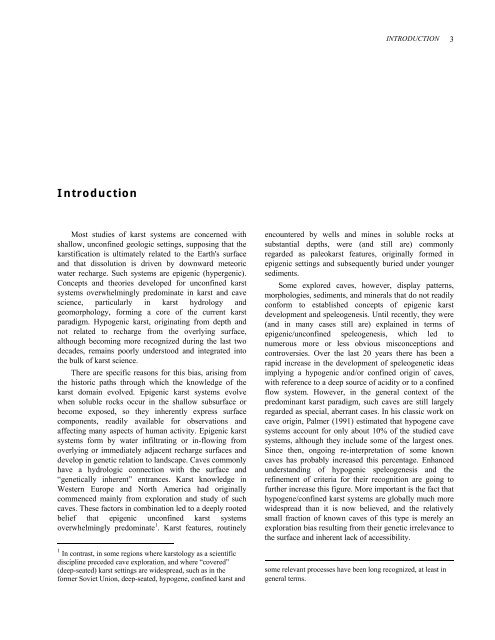Download PDF - Speleogenesis
Download PDF - Speleogenesis
Download PDF - Speleogenesis
You also want an ePaper? Increase the reach of your titles
YUMPU automatically turns print PDFs into web optimized ePapers that Google loves.
Introduction<br />
Most studies of karst systems are concerned with<br />
shallow, unconfined geologic settings, supposing that the<br />
karstification is ultimately related to the Earth's surface<br />
and that dissolution is driven by downward meteoric<br />
water recharge. Such systems are epigenic (hypergenic).<br />
Concepts and theories developed for unconfined karst<br />
systems overwhelmingly predominate in karst and cave<br />
science, particularly in karst hydrology and<br />
geomorphology, forming a core of the current karst<br />
paradigm. Hypogenic karst, originating from depth and<br />
not related to recharge from the overlying surface,<br />
although becoming more recognized during the last two<br />
decades, remains poorly understood and integrated into<br />
the bulk of karst science.<br />
There are specific reasons for this bias, arising from<br />
the historic paths through which the knowledge of the<br />
karst domain evolved. Epigenic karst systems evolve<br />
when soluble rocks occur in the shallow subsurface or<br />
become exposed, so they inherently express surface<br />
components, readily available for observations and<br />
affecting many aspects of human activity. Epigenic karst<br />
systems form by water infiltrating or in-flowing from<br />
overlying or immediately adjacent recharge surfaces and<br />
develop in genetic relation to landscape. Caves commonly<br />
have a hydrologic connection with the surface and<br />
“genetically inherent” entrances. Karst knowledge in<br />
Western Europe and North America had originally<br />
commenced mainly from exploration and study of such<br />
caves. These factors in combination led to a deeply rooted<br />
belief that epigenic unconfined karst systems<br />
overwhelmingly predominate 1 . Karst features, routinely<br />
1 In contrast, in some regions where karstology as a scientific<br />
discipline preceded cave exploration, and where “covered”<br />
(deep-seated) karst settings are widespread, such as in the<br />
former Soviet Union, deep-seated, hypogene, confined karst and<br />
INTRODUCTION<br />
encountered by wells and mines in soluble rocks at<br />
substantial depths, were (and still are) commonly<br />
regarded as paleokarst features, originally formed in<br />
epigenic settings and subsequently buried under younger<br />
sediments.<br />
Some explored caves, however, display patterns,<br />
morphologies, sediments, and minerals that do not readily<br />
conform to established concepts of epigenic karst<br />
development and speleogenesis. Until recently, they were<br />
(and in many cases still are) explained in terms of<br />
epigenic/unconfined speleogenesis, which led to<br />
numerous more or less obvious misconceptions and<br />
controversies. Over the last 20 years there has been a<br />
rapid increase in the development of speleogenetic ideas<br />
implying a hypogenic and/or confined origin of caves,<br />
with reference to a deep source of acidity or to a confined<br />
flow system. However, in the general context of the<br />
predominant karst paradigm, such caves are still largely<br />
regarded as special, aberrant cases. In his classic work on<br />
cave origin, Palmer (1991) estimated that hypogene cave<br />
systems account for only about 10% of the studied cave<br />
systems, although they include some of the largest ones.<br />
Since then, ongoing re-interpretation of some known<br />
caves has probably increased this percentage. Enhanced<br />
understanding of hypogenic speleogenesis and the<br />
refinement of criteria for their recognition are going to<br />
further increase this figure. More important is the fact that<br />
hypogene/confined karst systems are globally much more<br />
widespread than it is now believed, and the relatively<br />
small fraction of known caves of this type is merely an<br />
exploration bias resulting from their genetic irrelevance to<br />
the surface and inherent lack of accessibility.<br />
some relevant processes have been long recognized, at least in<br />
general terms.<br />
3
















